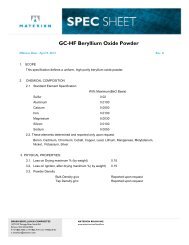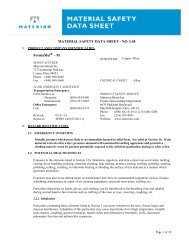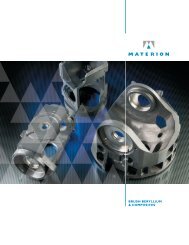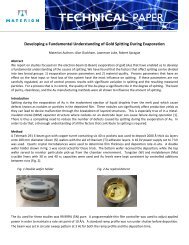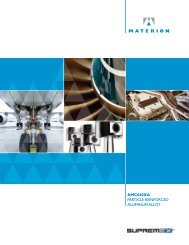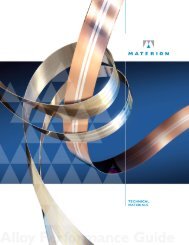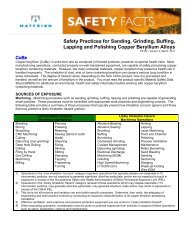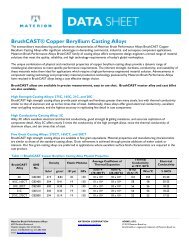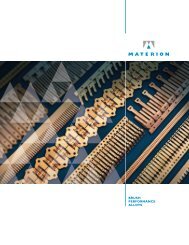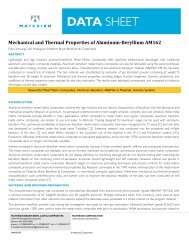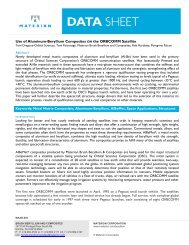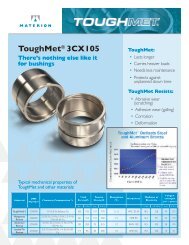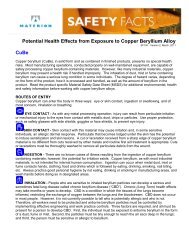A High Performance Beryllium Dome Diaphragm ... - Materion
A High Performance Beryllium Dome Diaphragm ... - Materion
A High Performance Beryllium Dome Diaphragm ... - Materion
- No tags were found...
Create successful ePaper yourself
Turn your PDF publications into a flip-book with our unique Google optimized e-Paper software.
Buck, et al.<strong>High</strong> <strong>Performance</strong> <strong>Beryllium</strong> <strong>Dome</strong> <strong>Diaphragm</strong>3.7 1 st Bending Mode (relative to aluminum)For a given geometry, the frequency of the first bending mode (break-up frequency) is related tothe speed of sound in the material. More accurately, the first bending mode varies as √(E/ρ (1-ν 2 )), according to Euler-Bernoulli plate theory (Kinsler & Frey). For the sake of clarity in thetable, these results have been shown relative to the 1 st Bending Frequency of the aluminumplate.The approximate shape of the 1 st bending mode is shown in Figure 1 below.Figure 1. 2D Mode Shape at 1 st Bending Frequency of a <strong>Dome</strong> <strong>Diaphragm</strong>.3.8 SummaryIn summary, from the material properties table above, one can readily see that beryllium has thelowest mass, the highest stiffness, the lowest Poisson Effect, the highest speed of sound, and thehighest tensile strength of the acoustically useful light metals. This excellent combination ofproperties results in a much higher bending stiffness for any given geometry, and thus a markedincrease in the first bending mode frequency of the diaphragm. What this means to the designerof large format compression drivers is more than an octave of useful frequency range from thesame driver geometry.4. MANUFACTURING PROCESSES<strong>Beryllium</strong> is inherently a hard metal, and has a reputation for being brittle in thin structures.However, manufacturing processes can have significant effects on the ductility of beryllium.There are two processes that are currently used to manufacture beryllium acousticcomponents.4.1 PVD <strong>Beryllium</strong>PVD is a process performed in a vacuum and is a general term used to describe any of a varietyof methods to deposit thin films by the condensation of a vaporized form of the material ontovarious surfaces. The coating method involves purely physical processes such as hightemperature vacuum evaporation or plasma sputter bombardment. The process used to vapordeposit beryllium produces a relatively coarse grain structure with grains oriented perpendicularto the plane of the deposited layer. The PVD process also places physical limits on the thicknessof the finished diaphragm.ALMA Europe Symposium 09 April, 2011Page 4 of 26
Buck, et al.<strong>High</strong> <strong>Performance</strong> <strong>Beryllium</strong> <strong>Dome</strong> <strong>Diaphragm</strong>4.2 Rolled <strong>Beryllium</strong> FoilRolled beryllium foil is produced using a process which creates a fine metallic grain structurewith grains oriented parallel to the direction of rolling. Precise control of the rolling processproduces beryllium foil with a highly uniform grain structure while minimizing residual strains inthe finished product. For many years, rolled beryllium foil was not used for acoustic applicationsdue primarily to the high price of the material. However, <strong>Materion</strong> Electrofusion developed amuch more cost effective rolling process and has been supplying the acoustic market withberyllium foil for over a decade.4.3 Comparison of PVD <strong>Beryllium</strong> vs. Rolled <strong>Beryllium</strong> FoilThe differences in the grain structure and grain orientation result in significant improvements inthe functional properties of rolled beryllium foils vs. PVD beryllium materials. When amoderate normal force is applied to PVD beryllium it is subject to catastrophic failure, whereasif the same moderate normal force is applied to rolled beryllium foil, it displays ductility similarto titanium and aluminum domes (i.e., it deforms). PVD beryllium typically fails by shatteringinto multiple pieces of various sizes. However, rolled beryllium foil typically tears or splits whenit fails, remaining cohesive if not functional. Currently, rolled beryllium foil is used in severalhigh performance transducers including near field studio monitors, consumer and professionalcompression drivers, and direct radiating tweeters for both home and automobile applications.5. ADDITIONAL IMPROVEMENTS TO THE LARGE FORMAT COMPRESSIONDRIVER DIAPHRAGM ASSEMBLYThe use of a rolled beryllium foil diaphragm has been shown to offer exceptional improvementsto large format compression driver performance regardless of geometry. However, there areseveral other aspects of the diaphragm assembly that also have room for improvement.5.1 Voice CoilThe voice coil is commercially pure aluminum that is fully annealed before flattening to allow foruniformity and minimal elongation during the wire flattening process. A Kapton® formerminimizes mass and mechanical losses while maintaining high rigidity between the coil and thediaphragm. The coil is bonded to the former using a high temperature aerospace adhesivetypically not used in the speaker industry. Electrical connections to the voice coil areaccomplished with two copper-beryllium lead out strips. These are soldered directly to the coilstack using special water-based flux which boils out during the subassembly curing cycle.Experience over the last 20 years with many thousands of coils has proven that this processprovides reliable solder connections with an extremely low number of voice coil failures in thefield.In order to maximize packing density, increase coil rigidity, and minimize mass, it is already wellknownthat edgewound flat aluminum wire is the best solution, giving a theoretical 27% greaterpacking density than round wire (Eargle), although realizable improvements may be more like17%. Most modern high performance compression drivers take advantage of this geometry. Wehave developed a proprietary winding method that enables even greater packing density,achieving additional gains of up to 3% to 7% over commercially available coils. The resultingincrease in Bl is well known to increase efficiency in a compression driver.ALMA Europe Symposium 09 April, 2011Page 5 of 26
Buck, et al.<strong>High</strong> <strong>Performance</strong> <strong>Beryllium</strong> <strong>Dome</strong> <strong>Diaphragm</strong>Table 2 below compares the packing density of our improved coil with that of two commerciallyavailable voice coils.Table 2: Comparison of Three Edge-Wound Flat Wire 16-Ohm Compression DriverVoice CoilsCoil Type Average Packing Density Relative Packing DensityBrand X 218.5 turns/in 100%Brand Y 227.3 turns/in 104%Improved Coil 232.9 turns/in 107%5.2 SurroundThere are two surround designs typically used for large format compression drivers. The mostcommon is to use the metallic dome material for the surround. These integral dome/surrounddesigns typically have some geometric relief provided to the surround portion such as a half roll,pleats, or indentations to reduce flexing stress and distortion. This type of surround has beenemployed with good performance results since the early development of compression drivers byWestern Electric in the 1920s. Careful forming methods are required in order to prevent themetallic foil material from work hardening during the forming process, potentially crackingunder subsequent use. Molding of the foil membrane is usually accomplished by pressureforming in a die. Early efforts spun the dome portion into the mold to provide differentproperties in the dome and surround areas. The single material membrane + surround is theleast expensive design, but does have certain limitations.A second more recent method is the use of a polymer surround. Kapton and Mylar® are themost common materials used as their mechanical properties allow greater flexing and minimizethe work hardening effects suffered by metallic surrounds. Some designs use a special moldableKapton that wraps around the voice coil making it part of the surround assembly and providegreater protection of the voice coil. Most polymer surrounds do not need geometric relief asthe material can flex sufficiently to provide the needed movement. While Kapton and Mylarshow a marked improvement over a metal surround, they do not represent the best technologyavailable today.A special polymer surround material was selected for use in the diaphragm assembly presentedhere. This polymer material was chosen specifically for its mechanical properties includingexcellent damping which contributes to the exceptionally smooth response of the diaphragm. Inaddition, the outstanding fatigue resistance of the surround material enables the diaphragmassembly to provide long life and excellent reliability with little or no change in performanceanticipated over the life of the diaphragm.Figures 2 and 3 show response curves taken before and after a 100-hour accelerated life test,comparing a popular high-performance titanium diaphragm assembly and the improved berylliumdiaphragm assembly of this presentation. As mentioned above, a metal surround will workharden with the flexing of continued use, causing the performance degradation that can be seenin both the frequency response and the 3 rd harmonic distortion curves for the titaniumALMA Europe Symposium 09 April, 2011Page 6 of 26
Buck, et al.<strong>High</strong> <strong>Performance</strong> <strong>Beryllium</strong> <strong>Dome</strong> <strong>Diaphragm</strong>diaphragm assembly. An average of 1.5dB is lost in the output below 3kHz, and there is anincrease of 5% in the 3 rd harmonic at 1kHz.Figure 2. Accelerated Life Test Data; Rolled <strong>Beryllium</strong> Foil <strong>Diaphragm</strong> Assembly.500Hz – 5,000Hz Pink Noise, 6dB CF, 12dB/octave slope. Note very small changes in frequencyresponse and minimal increase in distortion after 100 hour test.ALMA Europe Symposium 09 April, 2011Page 7 of 26
Buck, et al.<strong>High</strong> <strong>Performance</strong> <strong>Beryllium</strong> <strong>Dome</strong> <strong>Diaphragm</strong>Figure 3. Accelerated Life Test Data; Titanium <strong>Diaphragm</strong> Assembly.500Hz – 5,000Hz Pink Noise, 6dB CF, 12dB/octave slope. An average of 1.5dB is lost in theoutput below 3kHz, and there is an increase of 5% in the 3 rd harmonic at 1kHz after 100 hours.5.3 Final AssemblySpecial tooling has been built to facilitate the final assembly of the dome and surround to thecoil/former subassembly. The tooling uses novel techniques to apply precise pressure on alladhesion surfaces of the diaphragm assembly.Further, two aluminum clamp rings are employed to ensure high precision alignment of thesurround to the dome and coil in all directions during cure. An extended cure cycle is usedwith slow temperature ramp times to give the greatest and most reliable adhesive cure strength.ALMA Europe Symposium 09 April, 2011Page 8 of 26
Buck, et al.<strong>High</strong> <strong>Performance</strong> <strong>Beryllium</strong> <strong>Dome</strong> <strong>Diaphragm</strong>6. VIBRATION MODELS AND MEASUREMENTS6.1 Finite Element ModelingA finite element model was constructed using the geometry of the Truextent® brand 4 inch(100mm) diaphragm assembly. To resolve the natural frequencies of each material, this analysisintentionally ignores acoustic loads from the compression driver itself (no rear cap, no phaseplug, no horn), essentially modeling the dome in a vacuum. Each material’s properties are fedinto the model without changing the geometry. The first 6 bending modes are shown on thefollowing page.The mode shapes are, of course, similar for all the materials however the frequencies of thesemodes vary significantly. Table 3 below summarizes these natural frequencies.Table 3: Predicted Bending Mode FrequenciesNaturalFreq(kHz)Aluminum Titanium Ti n / Al n <strong>Beryllium</strong> Be n / Al n1 st mode 10.04 9.98 0.99 26.16 2.612 nd mode 10.44 10.36 0.99 26.64 2.553 rd mode 10.56 10.46 0.99 26.79 2.544 th mode 10.62 10.52 0.99 26.90 2.535 th mode 10.68 10.58 0.99 27.05 2.536 th mode 10.76 10.66 0.99 27.28 2.54First, notice that the Finite Element Model confirms the analytical solution above; if geometry isheld constant, beryllium’s bending modes occur at roughly 2.5x higher frequency than those ofthe other materials.Perhaps even more interesting is the acutely non-harmonic relationship of the modes above thefirst. Classical plate theory hints at this, but flat plates and membranes do not exhibit suchclosely-spaced modes. While beyond the scope of this study, it is certainly worth noting thatthe relationship between the natural frequencies is drastically affected by the geometry of thedome. The modal density above the first bending mode is much higher than that predicted byclassical (flat) plate theory. Essentially, this lends greater importance to the first bending modefrequency, since adjacent modes set in so quickly and densely above that frequency.ALMA Europe Symposium 09 April, 2011Page 9 of 26
Buck, et al.<strong>High</strong> <strong>Performance</strong> <strong>Beryllium</strong> <strong>Dome</strong> <strong>Diaphragm</strong>5015.6 Hz10007.8 Hz15000 Hz20015.6 HzFigure 5. Aluminum <strong>Dome</strong> Total Vibration at 5kHz, 10kHz, 15kHz, and 20kHz.ALMA Europe Symposium 09 April, 2011Page 12 of 26
Buck, et al.<strong>High</strong> <strong>Performance</strong> <strong>Beryllium</strong> <strong>Dome</strong> <strong>Diaphragm</strong>5015.6 Hz10007.8 Hz15000 Hz20015.6 HzFigure 6. Titanium <strong>Dome</strong> Total Vibration at 5kHz, 10kHz, 15kHz, and 20kHz.ALMA Europe Symposium 09 April, 2011Page 13 of 26
Buck, et al.<strong>High</strong> <strong>Performance</strong> <strong>Beryllium</strong> <strong>Dome</strong> <strong>Diaphragm</strong>5015.6 Hz10007.8 Hz15000 Hz20015.6 HzFigure 7. <strong>Beryllium</strong> <strong>Dome</strong> Total Vibration at 5kHz, 10kHz, 15kHz, and 20kHz.ALMA Europe Symposium 09 April, 2011Page 14 of 26
Buck, et al.<strong>High</strong> <strong>Performance</strong> <strong>Beryllium</strong> <strong>Dome</strong> <strong>Diaphragm</strong>7. ACOUSTIC PERFORMANCE TESTING7.1 Test Equipment and MethodsAll of the following tests were performed with a test setup that included a 2 inch terminatedplane wave tube (Buck), using a Bruel & Kjaer 1/4 inch microphone, Bruel & Kjaer 2619preampifier, 2801 power supply and an Audiomatica CLIO 10 QC Firewire PC Windows XP®measurement system with 192kHz sampling rate. System pressure calibration was performedusing a Bruel & Kjaer 4231 Calibrator. The nominal 16 Ohm drivers were driven with 4 VoltsRMS for a 1 Watt power level, except where noted. A comparison of frequency response,distortion, and time domain behavior of four diaphragms will be presented below.7.2 Frequency Response and Harmonic DistortionThe first data set is frequency response and distortion. Each curve is an average of threemeasurements taken at 120 degree rotation intervals on the PWT. This smooths out effects ofslight non plane wave behavior typical of large format compression drivers with 4 inchdiaphragms, particularly at and above 10kHz. All tests used a JBL 2450 driver assembly, with the1.5 inch to 2 inch throat adaptor in place. The 2 nd and 3 rd harmonic distortion curves wereraised 20dB to fit the graph. In all cases, the BLACK curve is the fundamental response, theGREEN curve is the 2 nd harmonic distortion, and the RED curve is the 3 rd harmonic distortion.The highest curve is the fundamental, the next one is the 2 nd harmonic and the lowest is the 3 rd .The distortion curves are displayed at the excitation frequencies. Scales and axis ratios followIEC recommended practice of 25 or 50dB/decade.Figure 8 shows the response and distortion of the aluminum diaphragm. Aluminum has longbeen the material of choice for compression driver diaphragms. It exhibits frequency responseabove 10kHz, unlike phenolic diaphragms, and is easy to form. Sound quality has been good.Figure 9 shows the response and distortion of the titanium non-ribbed diaphragm. The use oftitanium in compression driver diaphragms gained in popularity in recent decades due largely toits ruggedness. It also provides a high frequency output improvement over aluminum. Therewere some reports that sound quality was not as good as aluminum. (Murray)Figure 10 shows the response and distortion of the ribbed titanium diaphragm. The ribbing anddiamond pleat surround add stiffness, thus extending the high frequency response. The tradeoffis higher Q resonances above 10kHz.Figure 11 shows the response and distortion of the beryllium diaphragm. The berylliumdiaphragm exhibits a smooth, extended frequency response, and the distortion is comparable tothe other materials.ALMA Europe Symposium 09 April, 2011Page 15 of 26
Buck, et al.<strong>High</strong> <strong>Performance</strong> <strong>Beryllium</strong> <strong>Dome</strong> <strong>Diaphragm</strong>Figure 8. Response and Distortion - Aluminum <strong>Diaphragm</strong>.(Fundamental-Black; 2 nd Harmonic-Green; 3 rd Harmonic-Red)Figure 9. Response and Distortion - Titanium Nonribbed <strong>Diaphragm</strong>.(Fundamental-Black; 2 nd Harmonic-Green; 3 rd Harmonic-Red)ALMA Europe Symposium 09 April, 2011Page 16 of 26
Buck, et al.<strong>High</strong> <strong>Performance</strong> <strong>Beryllium</strong> <strong>Dome</strong> <strong>Diaphragm</strong>Figure 10. Response and Distortion - Ribbed Titanium <strong>Diaphragm</strong>.(Fundamental-Black; 2 nd Harmonic-Green; 3 rd Harmonic-Red)Figure 11. Response and Distortion - <strong>Beryllium</strong> <strong>Diaphragm</strong>.(Fundamental-Black; 2 nd Harmonic-Green; 3 rd Harmonic-Red)ALMA Europe Symposium 09 April, 2011Page 17 of 26
Buck, et al.<strong>High</strong> <strong>Performance</strong> <strong>Beryllium</strong> <strong>Dome</strong> <strong>Diaphragm</strong>7.3 Discussion of the Response and Distortion TestsThe four reponse and harmonic distortion plots above are traditional measurements, taken on aplane wave tube. The four diaphragms show differences in high frequency response, above 4kHz,while the lower frequency sensitivities are essentially equal. The distortion plots are similar, andare largely a function of the compression of the air in the phase plug. Low frequency distortionis related to suspension performance.7.4 Direct Response ComparisonsThe following frequency response graphs are on an expanded vertical scale to show in moredetail the differences between beryllium and the three competing technologies.Figure 12 shows the response of the beryllium diaphragm versus the aluminum diaphragm. Theberyllium diaphragm has substantially more output than the aluminum one from 4 to 18kHz,with a solid 6dB advantage at 10kHz.Figure 13 illustrates that the beryllium diaphragm has substantially more output than thenonribbed titanium one from 3 to 18kHz, with a solid 6dB advantage at 10kHz.Figure 14 shows the response of the beryllium diaphragm versus the ribbed titanium diaphragm.The beryllium diaphragm has substantially more output than the titanium one from 3 to 11kHz,with an average of 2.5dB advantage at 5 to 10kHz. The response of the beryllium diaphragm isalso much smoother in the top octave.Figure 15 shows the responses of all four diaphragms on a 100dB scale. The midrange effciencyis essentially equal with +/- 0.5dB at 2kHz. However, significant differences appear above 4kHz.ALMA Europe Symposium 09 April, 2011Page 18 of 26
Buck, et al.<strong>High</strong> <strong>Performance</strong> <strong>Beryllium</strong> <strong>Dome</strong> <strong>Diaphragm</strong>Figure 12. Response - <strong>Beryllium</strong> (purple) vs. Aluminum (grey) <strong>Diaphragm</strong>.Figure 13. Response - <strong>Beryllium</strong> (purple) vs. Nonribbed Titanium (lime) <strong>Diaphragm</strong>.ALMA Europe Symposium 09 April, 2011Page 19 of 26
Buck, et al.<strong>High</strong> <strong>Performance</strong> <strong>Beryllium</strong> <strong>Dome</strong> <strong>Diaphragm</strong>Figure 14. Response of <strong>Beryllium</strong> (red) vs Ribbed Titanium (brown) <strong>Diaphragm</strong>.Figure 15. Response - All Four <strong>Diaphragm</strong>s on a 100dB Scale.(<strong>Beryllium</strong>-purple; Aluminum-grey; Nonribbed Titanium-lime; Ribbed Titanium-brown)ALMA Europe Symposium 09 April, 2011Page 20 of 26
Buck, et al.<strong>High</strong> <strong>Performance</strong> <strong>Beryllium</strong> <strong>Dome</strong> <strong>Diaphragm</strong>Figure 16. Response - All Four <strong>Diaphragm</strong>s on a 25dB Scale.(<strong>Beryllium</strong>-purple; Aluminum-grey; Nonribbed Titanium-lime; Ribbed Titanium-brown)7.5 Summary of Frequency Response DifferencesIn these comparisons, the beryllium diaphragm exhibits substantially more output in the twooctaves from 3 to 12kHz than all of the standard materials. Only the ribbed titanium diaphragmhas some additional energy over the beryllium in the highest octave, but it is decidedly rougher.In professional audio, especially at larger venues, the top octave is less important as it tends tobe attenuated quickly with distance. However, if the user wants to boost that octave, it wouldbe preferable to do that on the smoother unit with the beryllium diaphragm.7.6 Wavelet Analysis of Time Domain BehaviorIn an attempt to address the sound quality issues voiced by some audio professionals, it wasdecided to look closely at the time domain behavior of each of these diaphragms. It is knownthat peaky frequency response is associated with a longer decay time. Perhaps the followingresults will provide insight into the relative performance of these materials in these applications.CLIO 10 QC has the capability of doing a wavelet analysis on the impulse response of thetransducer. The impulse responses were taken using the Maximum Length Sequence analysismode, and truncated to 11 milliseconds for the analysis.ALMA Europe Symposium 09 April, 2011Page 21 of 26
Buck, et al.<strong>High</strong> <strong>Performance</strong> <strong>Beryllium</strong> <strong>Dome</strong> <strong>Diaphragm</strong>CLIO's wavelet analysis tool is implemented using a kernel of modified complex Morlet waveletsand can be interpreted as a constant Q analysis. Time resolution is high at high frequencies andnot too low at low frequencies. Thus, the wavelet analysis overcomes the fixed time/frequencyresolution limitations of an FFT analysis.Here we used a Q of 3 and plotted the Scalogram relative to the peak energy in each spectralslice. This provides a detailed view of the energy decay of the transducer as a function offrequency.These data are presented in Figures 17 - 21 on the following pages. The color bar on the rightshows the hues over the 50dB scale of the energy, while the spectrum is on the vertical axis.The horizontal axis is time in milliseconds, from 0 to 11.Figure 17: Perfect WaveletFigure 17. Perfect Wavelet.Figure 17 shows a wavelet that was calculated from a direct electronic loopback through CLIO.The decay is approximately 1/f for each frequency.ALMA Europe Symposium 09 April, 2011Page 22 of 26
Buck, et al.<strong>High</strong> <strong>Performance</strong> <strong>Beryllium</strong> <strong>Dome</strong> <strong>Diaphragm</strong>Figure 18: Titanium Ribbed <strong>Diaphragm</strong> (Diamond Pleat Surround).Figure 18 shows that the titanium ribbed diaphragm shows the worst ringing of the fourdiaphragms, exhibiting long decay at both the upper two octaves and at 1kHz.Figure 19: Titanium Nonribbed <strong>Diaphragm</strong>.Figure 19 shows that the titanium diaphragm with no ribs is the second worst performer on thewavelet decay test, it suffers from the top octave and 1kHz ring.ALMA Europe Symposium 09 April, 2011Page 23 of 26
Buck, et al.<strong>High</strong> <strong>Performance</strong> <strong>Beryllium</strong> <strong>Dome</strong> <strong>Diaphragm</strong>Figure 20: Aluminum <strong>Diaphragm</strong>.Figure 20 indicates that the aluminum diaphragm has good decay behavior, both in the uppertwo octaves and at 1kHz.In a grey scale display (lacking the color of the .pdf file) it is more difficult to assess the probablesound quality implications of these acoustic decay scalograms. At least, it appears that thealuminum and the beryllium diaphragms have similar decay characteristics, and both are betterthan titanium in that regard.ALMA Europe Symposium 09 April, 2011Page 24 of 26
Buck, et al.<strong>High</strong> <strong>Performance</strong> <strong>Beryllium</strong> <strong>Dome</strong> <strong>Diaphragm</strong>Figure 21: <strong>Beryllium</strong> <strong>Diaphragm</strong>.Figure 21 illustrates that the beryllium diaphragm has the best top octave decay characteristicsof the four materials and shapes. There is a connection between the time domain behavior andthe frequency domain behavior. When there is a rough and peaky frequency response, then thetime domain response will show a long decay. This effect is particularly evident in the top octaveresponse and decay differences between the smooth, fast-decaying beryllium driver and thepeaky, long-ringing ribbed titanium driver.Although we have done no formal listening tests of this effect, it has long been stated by audioprofessionals that the titanium diaphragms do not sound as good as the original aluminum ones,but they are prized for their reliability (Murray).With the new development of a beryllium device that combines reliability with a smoothextended high frequency response, the pro audio industry has an additional option in itstoolbox.8. CONCLUSIONSThere are still many opportunities for improvement in today’s professional compression drivers.New materials and processes can contribute to better performance, more part-to-partconsistency, better reliability, and longer life cycles. The rolled beryllium foil gives clearperformance and durability advantages over other available diaphragm materials. Newsuspension materials and adhesives maintain that performance over a longer life, and carefullycontrolled manufacturing processes using precision parts ensure consistency and reliability.State of the art testing methods including use of terminated tubes, scanning laser displacementALMA Europe Symposium 09 April, 2011Page 25 of 26
Buck, et al.<strong>High</strong> <strong>Performance</strong> <strong>Beryllium</strong> <strong>Dome</strong> <strong>Diaphragm</strong>vibrometry, accelerated life testing, and experimentation with new engineered materials forflexible suspensions will facilitate continued progress in this field.9. ACKNOWLEDGEMENTSThis work was supported by <strong>Materion</strong> Electrofusion. The authors would like to acknowledgethe assistance of Martin Wolf, Edward Hefter, and Mr. Ulrik Skov of iCapture.dk whoperformed the Finite Element Modeling.10. REFERENCESAudio Engineering Society, AES1id – AES Information Document — Plane-Wave Tubes: Designand Practice.Brush Wellman Inc., Acoustic Properties of <strong>Beryllium</strong> White Paper — www.truextent.comBuck, M., Plane Wave Tubes – Uses and Limitations. Marshall Buck, Convention Paper 6268,October, 2004, Audio Engineering Society.Eargle, J. “Loudspeaker Handbook” (2 nd edition). Kluwer Academic Publishers, Boston.IEC 60263 International Standard: Scales and sizes for plotting frequency characteristics andpolar diagramsKinsler, L.E., Frey, A.R., et al. “Fundamentals of Acoustics” (4 th edition). John Wiley & Sons,Hoboken, NJ.Mowry, S., “An Engineering Materials Update”, Voice Coil Magazine Article, December 2008.Murray, Fancher - personal communicationNoticeJBL is a registered trademark of Harmon International Industries, Inc.Kapton is a registered trademark of E.I. DuPont de Nemours & Co.Mylar is a registered trademark of DuPont Teijin FilmsTruextent is a registered trademark of <strong>Materion</strong> Brush Inc.Windows XP is a registered trademark of Microsoft CorporationALMA Europe Symposium 09 April, 2011Page 26 of 26



